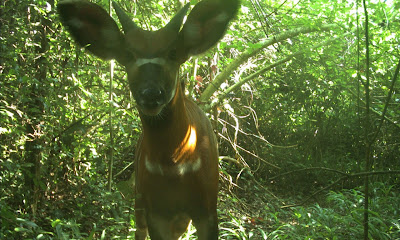By Sanjana Gajbhiye
Earth.com staff writer
Dated Wednesday, 13 March 2024
Giraffes have long been admired for their beauty and stateliness. However, scientists have recently discovered a surprising fact about these animals: they may not be just one species.
Researchers at the University of Copenhagen found evidence suggesting there may actually be four distinct giraffe species across Africa. This completely changes our understanding of giraffes. Recognizing four giraffe species would mean developing separate plans to protect each one.
Four giraffe species
Previously, all the giraffes were recognized as one species – Giraffa camelopardalis. The research provided strong genetic evidence that all the giraffes are distinct enough to be classified as separate species.
Northern Giraffe (Giraffa camelopardalis)
All Northern Giraffes have lighter colored spots. They are divided into three subspecies, each found in different geographical locations:
- Nubian giraffe: Found in Ethiopia and South Sudan.
- West African giraffe: Located in Niger.
- Kordofan giraffe: Inhabits Cameroon, Central African Republic, Chad, and possibly Sudan.
Reticulated Giraffe (Giraffa reticulata)
This species is also called the Somali giraffe, is known for its unique brown spots with clear white borders that look like a net. They live in northern Kenya, southern Ethiopia, and Somalia.
Masai Giraffe (Giraffa tippelskirchi)
Masai is the biggest and darkest colored of all, with patches shaped like stars that go all the way down to their hooves. You’ll find them in central and southern Kenya and throughout Tanzania.
Southern Giraffe (Giraffa giraffa)
Southern Giraffes have round or blotched spots, which are more uneven and less defined than the Reticulated Giraffe’s spots. They are classified further into two subspecies:
- South African giraffe: Inhabits northern South Africa, southern Botswana, southern Zimbabwe, and southwestern Mozambique.
- Angolan giraffe: Found in northern Namibia, southern Botswana, southwestern Zambia, and western Zimbabwe.
All of the groups are connected and some even mix, like the reticulated giraffe which has genes from both the northern and southern giraffe ancestors. The researchers were surprised by this interconnectedness.
“When we started getting results from our analyses of gene flow between different giraffe lineages, we had to check twice,” recalled Laura D. Bertola, a postdoc at the Department of Biology and one of the authors on the study.
Redefining giraffe species
This widespread mixing between giraffe groups throws a wrench into how we define a species. Traditionally, scientists thought extensive gene sharing only happened within a single species. But the giraffes’ story flips that idea on its head.
It suggests that the amount of genetic difference might not be the clear-cut way to identify new species as we once believed. “Our findings touch on a very delicate matter in biology, namely that we do not have a universally agreed species concept.” said Rasmus Heller, one of the senior authors.
Instead of trying to pinpoint the exact number of giraffe species, the study aims to highlight the fluidity of gene flow among giraffes, which remains possible under the right conditions.
Conservation of giraffe species
This discovery is a game-changer for giraffe species conservation. Traditionally, we’ve focused on protecting different species entirely. But this study emphasizes the need to consider the genetic variation within a species as well. Each giraffe lineage, regardless of its specific taxonomic classification, boasts a unique genetic makeup that deserves protection.
“Giraffes are such endlessly fascinating animals, and this study confirms just how much genetic variation there is even on small geographical scales,” noted Yoshan Moodley, a co-author of the study from the University of Venda in South Africa.
The findings from the University of Copenhagen are part of a broader effort under the African Wildlife Genomics research framework, associated with the African BioGenome Project.
The study is published in the journal Current Biology.
View original: https://www.earth.com/news/study-reveals-four-unique-giraffe-species-across-africa/
END















